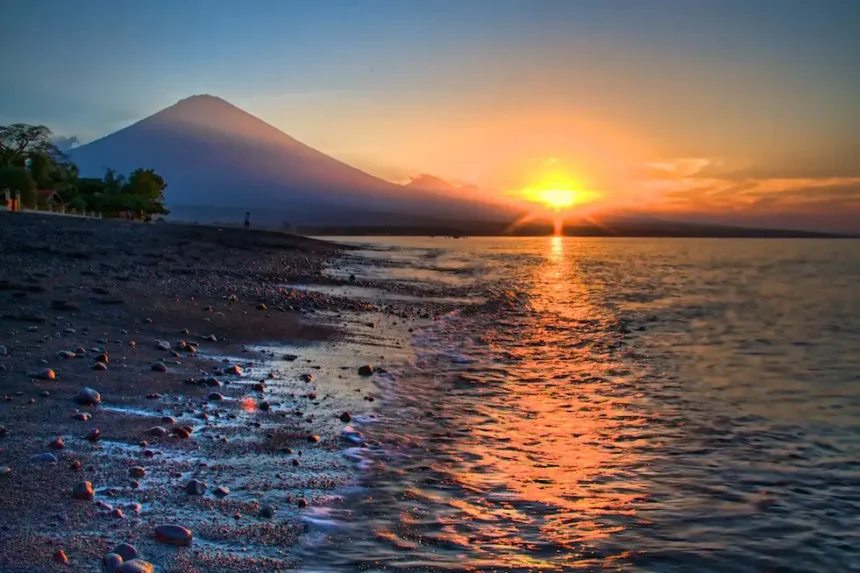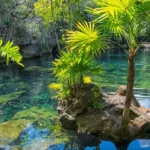Embark on an unforgettable journey with a Mount Agung trek, an adventure that takes you to the heart of Bali’s spiritual and natural wonders. This sacred volcano, revered by locals as the abode of gods, offers a challenging yet rewarding experience for trekkers of all levels. As you ascend its slopes, you’ll be captivated by breathtaking landscapes, immersed in rich cultural traditions, and rewarded with panoramic views that will leave you breathless. Whether you’re seeking a physical challenge, a spiritual pilgrimage, or simply a chance to connect with nature’s raw beauty, a Mount Agung trek promises an unforgettable adventure that will stay with you long after you’ve left the island.
Agung: Bali’s Sacred Volcano
Mount Agung, towering over Bali’s landscape, isn’t just a geographical marvel; it’s the island’s spiritual epicenter. Revered by locals as the abode of gods, this active volcano holds profound significance in Balinese Hinduism. Its majestic silhouette against the sky is a constant reminder of nature’s power and the island’s deep-rooted beliefs.
A trek to Agung’s summit isn’t merely a physical challenge; it’s a spiritual pilgrimage. As you ascend, you’ll traverse ancient trails that have witnessed centuries of devotion. The air grows thin, but the energy thickens, as you draw closer to the crater’s rim. The panoramic vistas that await are a testament to Bali’s natural beauty.
Whether you’re a seasoned trekker or a casual hiker, standing on Agung’s peak is an experience that will leave an indelible mark on your soul. The sense of accomplishment is amplified by the knowledge that you’ve conquered a mountain steeped in cultural significance. Agung is more than just a volcano; it’s an emblem of Bali’s spirit.
Planning Your Agung Trek
Embarking on a Mount Agung trek requires careful planning to ensure a safe and rewarding experience. Start by researching the different trekking routes available, each offering varying levels of difficulty and scenery. Consider your fitness level and experience before choosing the path that suits you best.
Securing the services of a knowledgeable local guide is highly recommended. They not only navigate the trails with expertise but also share insights into the mountain’s history, geology, and spiritual significance. Prepare for the trek by packing essential gear such as sturdy hiking boots, layered clothing for varying temperatures, a headlamp, plenty of water, and snacks.
Before setting off, it’s crucial to check the weather conditions and obtain any necessary permits. Mount Agung is an active volcano, and trekking is subject to safety regulations. By planning meticulously, you’ll be well-prepared to embrace the challenges and rewards that await on Agung’s slopes.
Best Time for Agung Ascent
Timing your Mount Agung trek is essential to maximize your chances of clear views and comfortable conditions. The dry season, from April to October, is generally considered the optimal period for trekking. During these months, rainfall is minimal, trails are less slippery, and the skies are clearer, offering breathtaking vistas from the summit.
However, if you prefer a quieter trek with fewer crowds, consider venturing during the shoulder seasons of March or November. While there might be a slight chance of rain, the trails are less congested, and the temperatures are still relatively pleasant.
It’s important to note that Mount Agung is an active volcano, and trekking conditions can change unexpectedly. Always check the latest safety advisories and weather forecasts before embarking on your adventure. By choosing the right time, you’ll enhance your chances of a successful and enjoyable Agung ascent.
Gear Up for Agung’s Challenge
Preparing for a Mount Agung trek requires packing the right gear to ensure your comfort and safety. Sturdy hiking boots with good ankle support are essential for navigating the rocky terrain. Dress in layers, as temperatures can vary significantly, especially at higher altitudes. Pack a waterproof jacket, a warm fleece, and a hat to protect yourself from the elements.
A headlamp is crucial for early morning starts and navigating in low-light conditions. Bring plenty of water to stay hydrated throughout the trek, as well as high-energy snacks to keep your energy levels up. A first-aid kit is always a good idea for minor injuries, and consider carrying a map and compass or a GPS device for navigation.
If you plan to camp overnight on the mountain, a lightweight tent, sleeping bag, and sleeping pad are essential. Don’t forget sunscreen, sunglasses, and insect repellent to protect yourself from the sun and insects. By packing thoughtfully, you’ll be well-equipped to tackle the challenges of Agung’s slopes.
Navigating Agung’s Trails
Mount Agung offers a variety of trekking routes, each with its own unique challenges and rewards. The most popular route starts from Pura Besakih, Bali’s largest and holiest temple complex. This trail is relatively well-maintained and offers stunning views of the surrounding landscape.
Another option is the Pasar Agung route, which is shorter but steeper, requiring a good level of fitness. This trail takes you through lush forests and offers glimpses of the volcano’s crater. Whichever route you choose, it’s important to follow the marked trails and heed the advice of your guide.
The terrain can be challenging, with steep sections, loose rocks, and volcanic ash. Take your time, rest when needed, and enjoy the journey. The sense of accomplishment upon reaching the summit is unparalleled, and the panoramic views of Bali’s coastline and neighboring islands are simply breathtaking.
Sunrise Spectacle at Agung
One of the most magical experiences on Mount Agung is witnessing the sunrise from its summit. The pre-dawn climb is a test of endurance, but the reward is worth every step. As the first rays of light pierce the darkness, the sky transforms into a kaleidoscope of colors, casting a warm glow over the island’s landscape.
The crater rim is a prime vantage point for this celestial spectacle. As the sun ascends, it paints the clouds with vibrant hues of orange, pink, and purple, creating a scene that seems straight out of a dream. The sense of awe and wonder is palpable as you witness nature’s artistry unfold before your eyes.
The sunrise at Agung is a reminder of the island’s spiritual connection to the natural world. It’s a moment of serenity and gratitude, a chance to reflect on the beauty of creation. Whether you’re a photographer seeking the perfect shot or a spiritual seeker in search of enlightenment, the sunrise at Agung is an experience that will stay with you forever.
Descent from Agung’s Heights
After basking in the glory of the sunrise, the descent from Mount Agung presents a new set of challenges and rewards. The trails can be slippery, especially after rain, so it’s important to tread carefully and use trekking poles for added stability.
Take your time, enjoy the changing scenery, and savor the sense of accomplishment that comes with conquering Bali’s highest peak. As you descend, the air grows warmer, and the vegetation becomes lusher, offering a refreshing contrast to the barren summit.
Along the way, you might encounter local villagers tending to their crops or herding their livestock. Take a moment to interact with them, learn about their way of life, and perhaps even sample some of their traditional snacks. The descent is a chance to reflect on your journey, appreciate the island’s natural beauty, and connect with its people.
Post Trek Relaxation in Bali
After the exhilarating challenge of summiting Mount Agung, Bali offers a plethora of options for post-trek relaxation and rejuvenation. Head to one of the island’s many spas for a traditional Balinese massage, known for its soothing techniques and use of aromatic oils.
Indulge in a soak in a natural hot spring, believed to have therapeutic properties that alleviate muscle soreness and promote relaxation. Alternatively, simply unwind on one of Bali’s pristine beaches, listening to the gentle lapping of waves and feeling the warm sand between your toes.
Bali’s culinary scene is a haven for food lovers, offering a diverse array of flavors from local warungs serving authentic Balinese dishes to upscale restaurants showcasing international cuisine. Treat yourself to a delicious meal and savor the island’s unique culinary delights.
Agung’s Cultural Significance
Mount Agung holds immense cultural and spiritual significance for the Balinese people. It is considered the dwelling place of the gods, and its slopes are dotted with ancient temples and shrines. The most prominent of these is Pura Besakih, Bali’s mother temple, which sits at the foot of Agung.
This sprawling complex of intricately carved gates, courtyards, and towering shrines is a testament to the island’s rich architectural heritage and deep-rooted religious beliefs. Pilgrims from all over Bali flock to Pura Besakih to offer prayers and seek blessings from the gods.
The Balinese believe that Mount Agung is the center of the universe and that its eruptions are a sign of the gods’ displeasure. They offer regular ceremonies and offerings to appease the deities and maintain harmony between the natural and spiritual worlds. A visit to Pura Besakih is a must for anyone seeking to understand the cultural significance of Mount Agung and its role in Balinese life.
Safety First on Agung’s Slopes
While Mount Agung offers a rewarding trekking experience, it’s important to prioritize safety at all times. The volcano is active, and eruptions can occur unexpectedly. Always check the latest safety advisories and weather forecasts before embarking on your trek.
Choose a reputable trekking company and a knowledgeable local guide who is familiar with the mountain’s terrain and potential hazards. It’s essential to follow their instructions and stay on the marked trails. Be prepared for changing weather conditions, as temperatures can drop significantly at higher altitudes, and rain can make the trails slippery.
Carry a first-aid kit, plenty of water, and high-energy snacks. If you feel unwell or experience any difficulty, don’t hesitate to inform your guide. By taking necessary precautions and being mindful of your surroundings, you can ensure a safe and enjoyable trek on Mount Agung.
Responsible Trekking on Agung
As a responsible traveler, it’s important to minimize your impact on Mount Agung’s fragile ecosystem and respect the local culture. Stick to designated trails to avoid damaging vegetation and disturbing wildlife. Pack out all your trash, including food wrappers and plastic bottles, to keep the mountain pristine.
Be mindful of noise levels, especially near temples and shrines, as these are sacred sites for the Balinese people. Dress modestly, covering your shoulders and knees, as a sign of respect for their cultural norms. Avoid taking photos of people praying or participating in religious ceremonies without their permission. By being a responsible trekker, you can help preserve Mount Agung’s natural and cultural heritage for future generations.
Agung: Memories to Last a Lifetime
A trek to Mount Agung is more than just a physical challenge; it’s an unforgettable journey that will leave a lasting impression on your heart and soul. The stunning landscapes, the spiritual energy, and the cultural immersion create a unique experience that you’ll cherish forever.
The memories of witnessing the sunrise from Agung’s summit, exploring ancient temples, and interacting with the friendly locals will stay with you long after you’ve left the island. You’ll carry with you a sense of awe for nature’s power, a deeper understanding of Balinese culture, and a newfound appreciation for the simple things in life.
Mount Agung is not just a destination; it’s a transformative experience that will inspire and uplift you. Whether you’re a seasoned adventurer or a first-time trekker, the memories you create on Agung’s slopes will be etched in your mind forever.











